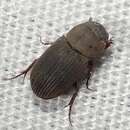Comprehensive Description
(
Inglês
)
fornecido por Smithsonian Contributions to Zoology
Ataenius imbricatus (Melsheimer)
Aphodius imbricatus Melsheimer, 1844:136.
Ataenius imbricatus.—Harold, in Gemminger and Harold, 1869:1066.—Horn, 1887:75.—Schmidt, 1922:443.—Chapin, 1940:20.—Petrovitz, 1962:131.
Ataenius sordidus Harold, 1869:103.—Horn, 1887:75.
DESCRIPTION.—Length 3.3 to 4.3 mm; width 1.6 to 2.0 mm. Dull, grayish brown to grayish black, legs dark brown; oblong, moderately convex; surface finely alutaceous, usually with more or less argillaceous appearance, covered with short, stubby setae, those of the elytral intervals closely spaced in longitudinal rows. Head convex, clypeus broadly rounded each side of moderately deep anterior median emargination, sides weakly arcuate to nearly straight, the genae rounded, edge finely reflexed; surface narrowly shining, smooth, and concave along anterior margin in front of close, fine punctures which gradually merge into close lines of united punctures over greatest convexity, at sides and base of clypeus the lines long and close, separated usually by less than their width; frontal area well marked by dense, much larger punctures; head punctures bear extremely short, inconspicuous setae. Pronotum one and one-half times as wide as long, about one-half as long as elytra, sides almost straight and parallel, margined laterally and basally, the edge weakly crenate with short, stubby setae generally separated by more than their length, anterior angles obtusely rounded, posterior angles rounded but distinct; surface, except for a slightly depressed median basal area and one (or sometimes two) small, short diagonal area(s) on each side, smooth, sometimes conspicuous; the entire surface covered with dense, very moderate, frequently inconspicuously setose punctures. The anterior angles project forward slightly, the base usually noticeably arcuate. Humeri strongly dentate. Elytra about twice as long as wide, sides curved inward around shoulders, anteriorly nearly straight and parallel. In freshly emerged specimens the elytral striae are moderately wide and deep, shining, with deep, moderate punctures separated by about three times their diameters, the intervals slightly crenated along inner margin; intervals on disc flat, increasingly convex toward sides except 10th interval, which is nearly flat, all are distinctly alutaceous and have a row of close, short, stubby setae along the outside margin, occasionally a few setae widely scattered along the inner margin also. Mesosternum weakly carinate between coxae. Metasternum with an unusually long, moderately fine and deep midline, finely alutaceous disc with close, shallow, moderate punctures separated by their diameter or less, roughly scabrous outward to sides, the metasternal triangle weak, shallow, and not well defined. Abdominal sterna minutely alutaceous, fluted along anterior margin, the fluting longer on each succeeding sternum, flutings at middle of 5th sternum much deeper and half as long as the sternum, closely, quite coarsely, shallowly punctate from side to side. Eroded area of pygidium scabrous, alutaceous. Anterior femora with perimarginal groove, surface rough, closely, setigerously punctate. Middle femora closely, setigerously punctate, posterior femoral line complete. Posterior femora similar but not quite as closely punctate, femoral line strong and complete. Posterior tibial fringe of five setae but the middle seta opposite the tarsus greatly reduced and very short, accessory spine lacking, first tarsal segment longer than long spur, longer than following three segments combined. The male pygidium is longer than that of the female.
HOLOTYPE;.—In Museum of Comparative Zoology.
TYPE-LOCALITY.—“Pennsylvania.”
SPECIMENS EXAMINED.—400+.
DATES COLLECTED.—March 6 to November 13.
DISTRIBUTION (Figure 7).—Alabama: Auburn, Dadeville, Gulf State Park, Mobile, Salt Mtn. (Clarke County). Arkansas: Devils Dam State Park, Hartford, Hope, Monte Ne Br. (Benton County). Delaware: Georgetown, Rehoboth. District of Columbia. Florida: Archbold Biological Station, Chipley (5 mi E), Daytona, Dunedin, Edgewater, Enterprise, Fort Myers, Gainesville, Haulover, Highlands Hammock State Park, Indian River, Key West, Kissimmee, Korishan State Park (Lee County), LaBelle, Lakeland, Lake Letta, Lake Placid, Lake Wales, Melbourne, Naples (9 mi N), Orlando, Pensacola, Perrine, Punta Gorda, Sanford, Silver Lake Recreation Area (Leon County), Stock Island, Tampa, Wakulla County, Washington County, West Palm Beach, Zolfo Springs. Georgia: Atlanta, Augusta, Demorest (Habersham County), Hinesville, Milner, Waycross. Illinois: “ Illinois” (Ulke Coll., Carnegie Museum). Indiana: Grantsburg, Lake County, Tremont. Kentucky: Louisville, Wolf Creek Lake (Wayne County). Louisiana: Covington, Gueydan, Harahan, Sam Houston State Park, Shreveport. Maryland: Glen Burnie, Hebbville, Hyattsville, Lanham, Marlboro, Sherwood Forest, Tacoma Park. Massachusetts: Chicopee, Tingsboro. Michigan: Detroit, Midland County, Oakland County, Port Huron. Minnesota: Alexandria, Minneapolis, St. Paul. Mississippi: Gulfport, Horn Island, Lucedale, Ocean Springs. Missouri: Nevada (Vernon County). Nebraska: Brown County (extreme NW corner), Halsey, Holt County, Neligh. New Hampshire: “New Hampshire.” New Jersey: Anglesea, Atlantic City, Ocean County, Prosportown, Sea Island City, Wildwood. New York: Peekshill, Rosedale. North Carolina: Balsam, Black Mtns., Buck Forest, Cedar Mtn., Clarkton, Falsom, Raleigh, Swan Quarter. Ohio: Holgate, Marietta. Oklahoma: Broken Bow, McCurtain County, Texhoma (near Willis). Pennsylvania: Philadelphia, Scarlet Hills. South Carolina: Blackville, Charleston, Clemson, Columbia, Florence, Folley Beach, Jocassee, Liberty, Sullivans Island, Yemassee. South Dakota: Elk Point. Tennessee: Cookeville, Reelfoot Lake. Texas: Anderson County, Columbus, Corpus Christi, Galveston, Kingsville, Lake Refugio, Linden, Lolita, Victoria. Virginia: Big Cobbler Mtn. (Fauquier County), Blacksburg, Cape Henry, Chatham, Dumfries (Prince William State Park), Fort Myer, Fort Monroe, Middleburg, Nelson County, Norfolk, Rosslyn, Sweet Briar (Amhurst County), Suffolk (Dismal Swamp), Williamsburg. West Virginia: Hamlin, Orkway Springs. Wisconsin: Bayfield, Carol Beach (Kenosha County), Friendship (Adams County), Wood County. Canada: Ontario: Dunnville, Point Pelee.
puncticollis ● imbricatus
- citação bibliográfica
- Cartwright, Oscar Ling. 1974. "Ataenius, Aphotaenius, and Pseudataenius of the United States and Canada (Coleoptera: Scarabaeidae: Aphodiinae)." Smithsonian Contributions to Zoology. 1-106. https://doi.org/10.5479/si.00810282.154


